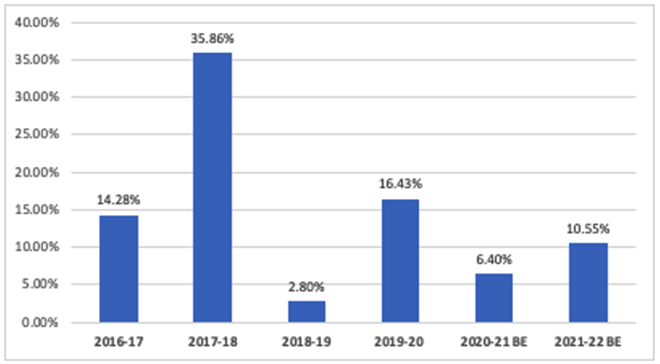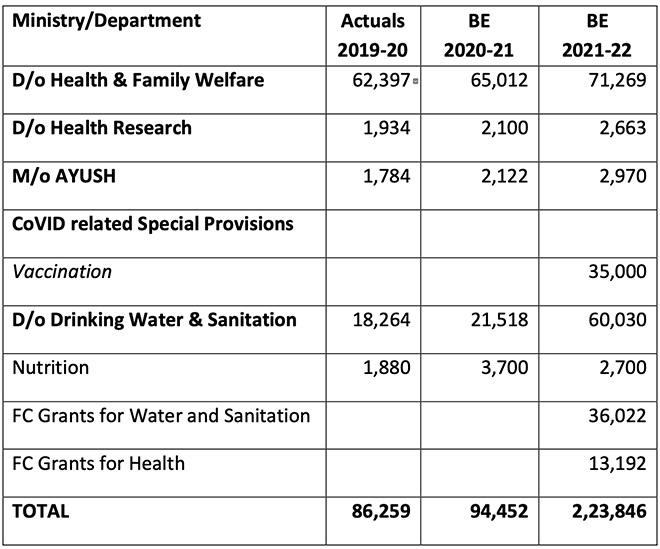
Today’s budget speech was one of the very few — if not the only — in India’s history where defence allocation was not mentioned. Yet, it remained a war budget, given the lingering threat of the pandemic, which devastated both lives and livelihoods in the country and across the world for most of 2020. When the Finance Minister announced that the outlay for ‘health and wellbeing’ in the current budget is INR 223,846 crores as against the previous year’s budget estimate of INR 94,452 crores (an increase of 137%), it was expected that wide-ranging reforms supported by substantial investments are underway.
From 2018, when the Pradhan Mantri Jan Arogya Yojana (PMJAY) was launched, a number of experts have expressed concern that the scheme will start absorbing more and more funds from an already limited budget, at the cost of improvement of rural health infrastructure. However, the Economic Survey 2020-21 had put this fear to rest, explaining the government’s position in clear terms. The Survey observed that the National Health Mission (NHM) has played a critical role in mitigating health inequity, and, therefore, in conjunction with Ayushman Bharat, the emphasis on NHM should continue. Expectations from this budget of India finally transcending the false dichotomy of delivery vs. financing, by investing simultaneously in robust public healthcare delivery systems as well as accountable demand-side financing mechanisms to leverage the private sector, were high.
In addition, given the high dependency on private infrastructure, and the prevalent market failure emerging from information asymmetry in the healthcare sector, the Survey endorsed the need for a regulator to undertake regulation and supervision, which has been a longstanding demand from the research community and civil society in India. The Survey presented its analysis in the context of low levels of public health expenditure, and presented evidence on situations where government spending as a proportion of GDP is less than three per cent; any improvement in that proportion leads to a sharp fall in out of pocket (OOP) expenditure. According to the Survey, an increase in public health expenditure from the current levels in India to 3% of GDP can reduce the OOP expenditure from 60% currently to about 30%, which can free up substantial funds for Indian Households to spend on other needs, and help many exit perennial debt-traps.
Expectations from this budget of India finally transcending the false dichotomy of delivery vs. financing, by investing simultaneously in robust public healthcare delivery systems as well as accountable demand-side financing mechanisms to leverage the private sector, were high.
All of this meant that expectations of a sector-wide enhancement of health investments were high. However, the actual numbers (Figure 1) from the budget, released shortly after the speech, has dashed any such hopes. According to the budget documents, between budget estimates of Budget 2020 and Budget 2021, there is only a paltry increase of 10.5%, when the requirements on the ground are desperately larger. The amount allocated this year — INR 74,602 crores — is in fact 10% lower than the revised estimates from the previous year, which was INR 82,445 crores. There are additional funds for COVID-19 vaccinations, and in all likelihood, just like the previous year, the allocation will be upwardly revised according to need. However, when the threat of the pandemic is still very much alive, the budget document demonstrates a concerning lack of intent, signaling the states are to bear the burden.
Figure 1: Percentage Increase in Central Funds in the Health Sector
 Source: Budget Documents Across Various Years.
Source: Budget Documents Across Various Years.
If that is the case, how did we reach the 137% increase in year-on-year allocation for ‘health and wellbeing,’ as the budget speech claimed? A look at the budget numbers shows that it is mostly the result of deft bookkeeping rather than any actual increase in the health sector. Indeed, a new centrally sponsored scheme, PM Atma Nirbhar Swasthya Bharat Yojana, has been announced with an outlay of about INR 64,180 crores over six years, which plans to develop the capacities of primary, secondary, and tertiary care systems, helping to strengthen capacities from detection to cure. However, the annualised allocation remains modest, and the real catch is the operational definition of ‘health and wellbeing.’
A look at the budget numbers shows that it is mostly the result of deft bookkeeping rather than any actual increase in the health sector.
Table 1: Allocation for Health and Wellbeing
 Source: Budget Speech 2021
Source: Budget Speech 2021
The ‘health and wellbeing’ category is dominated by water and sanitation, and given the government’s focus on universal coverage of drinking water supply, it has seen an almost 300% increase in allocations. At the same time, a look at the year-on-year allocations disaggregated between components of ‘health and wellbeing’ (Table 1) demonstrates clearly that the health sector is not getting funds in proportion to the huge pandemic challenge it faces. Apart from the Central support for vaccination (INR 35,000 crores) and the Finance Commission Grants to the health sector (INR 13,192 crores), the increases are fairly modest, amounting overall to 10.5%.
Given the daunting challenges of 2021, and the opportunity that the pandemic presented to reform the health sector, Budget 2021 unfortunately remained firmly within a disappointing but familiar ‘more-of-the-same’ framework. The true repercussions of the Centre passing on the responsibility of fighting the pandemic and maintaining infrastructure to provide non-Covid-19 services to the States will be seen only in the months to come. This will be all the more challenging, since the public healthcare infrastructure at the state level is already overwhelmed by the responsibility of conducting the biggest vaccination drive ever. Big ticket investments to enhance access to water are praiseworthy, but unfortunately, one cannot expect to fight a pandemic by only using externalities from the water sector. We need more investments for India’s health — a fact starkly neglected by the Budget 2021, which ended up being yet another lost opportunity for India’s health sector.
The views expressed above belong to the author(s). ORF research and analyses now available on Telegram! Click here to access our curated content — blogs, longforms and interviews.




 Source:
Source:  Source:
Source:  PREV
PREV


